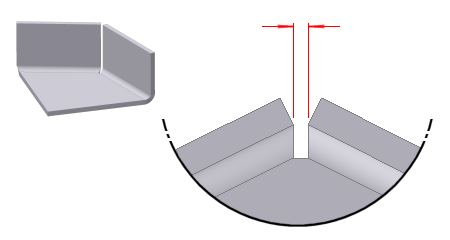 |
Corner seam features can be created automatically during the creation of other features or manually applied as needed during the design process. An automatic corner feature can most easily be illustrated when two flange features are created using identical parameters on adjacent edges of a sheet metal face (as seen in the illustration at left). |
Whether applied automatically or manually, corner seams provide options that define how the faces meet along the seam (distance and positions), and how the bends are relieved in the flat pattern. During creation, these options default to the values and settings defined by the sheet metal rule, but can be changed to suit design specifics unique to an individual corner.
| Face/Edge Method - A method for applying a seam gap based on a measurement from the flange face associated with the first selected edge to the second selected edge. This method is only supported when corner seams are manually applied using the Corner Seam feature. Corner seams created by releases of Autodesk Inventor before R2008 used this method exclusively. Corners that are created automatically by the Flange or Contour Flange feature use the Maximum Gap Distance method described in the following section. | |
|
Maximum Gap Distance Method - A method for applying a seam gap that can be measured by sliding a physical inspection gage of a thickness equal to the supplied gap distance value between and along the edges and faces of the resulting corner. The benefits of this method are most apparent for non-square corners (angles greater or less than 90 degrees). Corners that are created automatically by the Flange or Contour Flange feature utilize the Maximum Gap Distance method exclusively. This method provides more control in specifying gaps not previously possible using the Face/Edge method described previously as illustrated by the enlarged gap detail of the part shown in the following image: |
|
 |